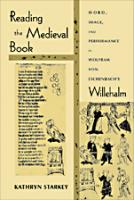Reading the Medieval Book
 Reading the Medieval Book examines one of the most important epic poems in thirteenth-century Germany and its redaction in a richly illustrated manuscript created just fifty-five years after the poem's composition. Starkey's book reveals that the Munich-Nuremberg manuscript (c.1270) of Wolfram von Eschenbach's Willehalm (c.1215) was compiled with both oral performance and the written medium in mind.
Reading the Medieval Book examines one of the most important epic poems in thirteenth-century Germany and its redaction in a richly illustrated manuscript created just fifty-five years after the poem's composition. Starkey's book reveals that the Munich-Nuremberg manuscript (c.1270) of Wolfram von Eschenbach's Willehalm (c.1215) was compiled with both oral performance and the written medium in mind.
Wolfram contrasts the visual language of the court with the auditory one of the battlefield, drawing attention to the position of the narrator and the interpretive frame that he provides. The manuscript reflects Wolfram's clear interest in the oral and visual communication that played such a dominant role in court society of the thirteenth century. Starkey argues that rather than merely depicting the events of Willehalm's plot, the Munich-Nuremberg artists also visualized nuances and shifts in the text that may otherwise have become lost when the oral text was committed to the page. The Munich-Nuremberg redaction of Willehalm provides insight into the critical transition in the literary culture of lay people in the West from a primarily oral to a literate experience. [from the UNDP web page]


